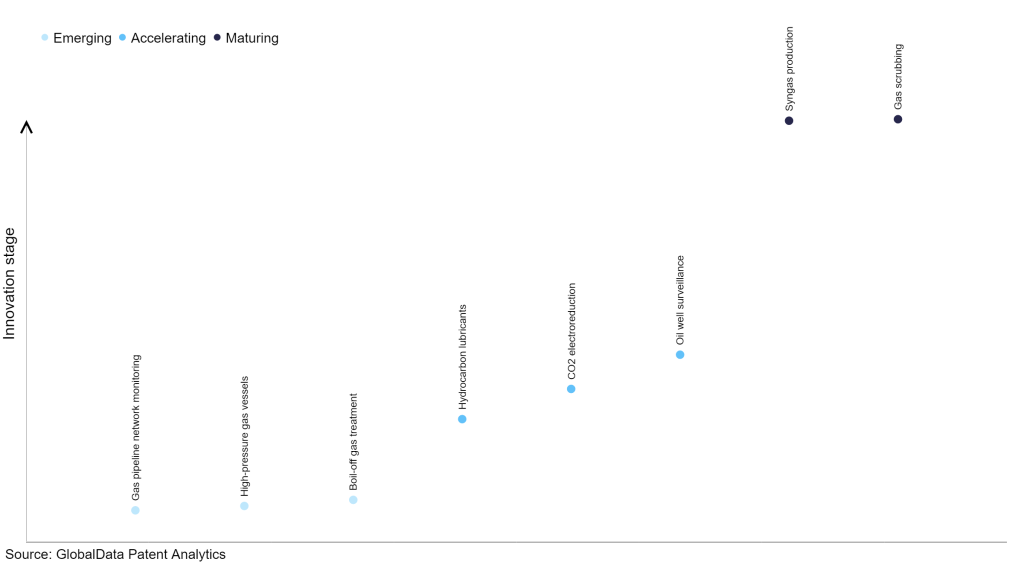The oil & gas industry continues to be a hotbed of patent innovation. Activity is driven by cost-effectiveness, operational efficiency, and enhanced safety, and growing importance of technologies such as artificial intelligence, cloud computing, and big data. In the last three years alone, there have been over 327,000 patents filed and granted in the oil & gas industry, according to GlobalData’s report on Innovation in oil & gas: cryogenic natural gas liquefaction. Buy the report here.

Discover B2B Marketing That Performs
Combine business intelligence and editorial excellence to reach engaged professionals across 36 leading media platforms.
However, not all innovations are equal and nor do they follow a constant upward trend. Instead, their evolution takes the form of an S-shaped curve that reflects their typical lifecycle from early emergence to accelerating adoption, before finally stabilizing and reaching maturity.
Identifying where a particular innovation is on this journey, especially those that are in the emerging and accelerating stages, is essential for understanding their current level of adoption and the likely future trajectory and impact they will have.
65+ innovations will shape the oil & gas industry
According to GlobalData’s Technology Foresights, which plots the S-curve for the oil & gas industry using innovation intensity models built on over 201,000 patents, there are 65+ innovation areas that will shape the future of the industry.
Within the emerging innovation stage, gas pipeline network monitoring, high-pressure gas vessels, and boil-off gas treatment are disruptive technologies that are in the early stages of application and should be tracked closely. Hydrocarbon lubricants, CO2 electroreduction and oil well surveillance are some of the accelerating innovation areas, where adoption has been steadily increasing. Among maturing innovation areas are syngas production and gas scrubbing, which are now well established in the industry.
Innovation S-curve for the oil & gas industry

Cryogenic natural gas liquefaction is a key innovation area in oil & gas
Cryogenic natural gas liquefaction involves subjecting natural gas at cryogenic temperatures to convert it into liquefied natural gas (LNG). This shrinks natural gas volume by 600 times and helps in safer and easier transportation.
GlobalData’s analysis also uncovers the companies at the forefront of each innovation area and assesses the potential reach and impact of their patenting activity across different applications and geographies. According to GlobalData, there are 65+ companies, spanning technology vendors, established oil & gas companies, and up-and-coming start-ups engaged in the development and application of cryogenic natural gas liquefaction.
Key players in cryogenic natural gas liquefaction – a disruptive innovation in the oil & gas industry
‘Application diversity’ measures the number of applications identified for each patent. It broadly splits companies into either ‘niche’ or ‘diversified’ innovators.
‘Geographic reach’ refers to the number of countries each patent is registered in. It reflects the breadth of geographic application intended, ranging from ‘global’ to ‘local’.
Air Products and Chemicals is the leading patent filer in cryogenic natural gas liquefaction. Other top players in the field include Air Liquide, Linde, Exxon Mobil, and Chart Industries. The cryogenic LNG heat exchangers manufactured by the company operate in more than 100 LNG trains across the world.
Linde introduced efficient cryogenic technologies for cost-effective distribution of LNG for developing LNG infrastructure. Air Liquide Engineering & Construction offers robust cryogenic liquefaction technologies. For small-scale LNG plants, it has introduced Turbofin, a Nitrogen Refrigerant Technology. For small to mid-scale LNG, it has introduced Smartfin, which is a single mixed refrigerant technology. And for large-scale LNG plants, it offers Liquefin, a dual mixed refrigerant technology.
In terms of application diversity, Air Products and Chemicals leads the pack, while Air Liquide and Linde stood in the second and third positions, respectively. By means of geographic reach, Halliburton held the top position, followed by Saudi Arabian Oil and Expansion Energy.
To further understand the key themes and technologies disrupting the oil & gas industry, access GlobalData’s latest thematic research report on Oil & Gas.
Data Insights
From

The gold standard of business intelligence.
Blending expert knowledge with cutting-edge technology, GlobalData’s unrivalled proprietary data will enable you to decode what’s happening in your market. You can make better informed decisions and gain a future-proof advantage over your competitors.




